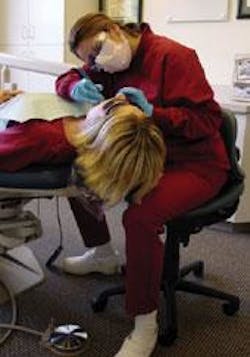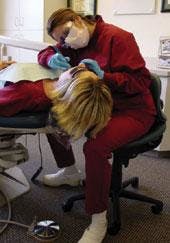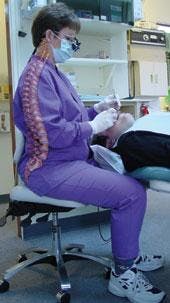Chairside Stretching
by Bethany Valachi, MS, PT, CEAS
Maybe you know her — the hygienist who frequently complains about discomfort in the neck and shoulders, yet boldly plows through her daily schedule. She's had several painful episodes, but she works through the pain again and again. By the end of her fourth year in practice, she experiences numbness and tingling in her right arm and hand and pain in her right shoulder and neck.
Her doctor advises her to cut her work to two days a week or risk permanent disability. She doesn't think this is an option for her, so she continues her busy work schedule for several more years, each time pushing through pain that's a little worse than before.
When she finally seeks help, it's in desperation. Her pain is now in the acute stage, and structural damage seems probable. By then, her level of pain rivals a physical therapist's level of frustration. Why do many hygienists wait until pain becomes acute before they contact a therapist?
Of all health professionals, hygienists not only know the importance of prevention, they teach it to their patients every day! How do you feel when patients ignore your advice about oral hygiene, then appear several years later with advancing periodontal disease or new decay? Even though they know better, many hygienists work through their discomfort day after day, despite the fact that they might cause irreversible structural damage. Only when the pain becomes acute do some hygienists take action. But by this time permanent damage often has occurred.
Do you consider neck and shoulder pain an accepted hazard of the job? The answer should be no. Are you one of the five out of six hygienists who experiences musculoskeletal pain? (1999 Swedish study) Or are you one out of five hygienists who left her career due to a musculoskeletal disability? A Canadian insurance company report stated that hygienist disability claims rose from five to 32 claims per year between 1991 and 1996.
These rising statistics are also spawning much-needed research into hygienist's health. Although most musculoskeletal research has been conducted in Sweden on dentists, some studies indicate that hygienists may experience even more musculoskeletal pain than dentists.
The culprits
The key to injury prevention lies not in a single pill, pair of loupes, or daily abdominal exercise, but in identifying and addressing multiple key risk factors. Click here to view chairside stretching techniques. The following risk factors can lead to work-related pain:
o Prolonged, awkward postures
o Forceful, repetitive movements
o Muscle imbalances
o Improper positioning of operator or patient
o Operatory layout
o Lack of magnification
o Poor or improper adjustment of ergonomic equipment
o Infrequent breaks
o Poor flexibility
o Weak postural muscles
o Stress
Of these risk factors, prolonged, awkward posture is the greatest culprit for the demise of hygienist's musculoskeletal health. The body is designed to tolerate brief awkward postures, such as arms elevated and head forward. It is not designed to hold these awkward postures for several minutes at a time throughout the day, as many hygienists do.
Prolonged, awkward postures
Neutral posture of the spine, shoulders, arms, and hands should be your first line of defense against work-related pain. Maintaining this posture throughout the day requires strong stabilizing muscles of the trunk and shoulder girdle. (However, strengthening the wrong muscles can cause far more problems than not strengthening at all.) If posture deviates from neutral, the muscles must contract harder to maintain working posture. As these postural muscles become fatigued, slouched posture often results, causing muscle compensation and subsequent pain. An abundance of literature is available on proper operator posture, positioning, and magnification. However, there are few resources on correct strengthening for dental professionals (see author's biographical information).
You should make every effort to preserve the three primary curves of your spine (cervical, thoracic and lumbar) when you are operating (see figure 1). Have a colleague assess your posture from the side. You should be able to draw a straight line through your ears, shoulders and hips. However, in the operatory it is nearly impossible to keep your head in a neutral posture all the time. Magnification can help decrease forward head tilt and enhance visibility of the oral cavity.
Even with the best ergonomic equipment and postural/positioning intentions, you may still find yourself in awkward postures. These postures often involve forward bending and twisting of the head, neck, and trunk (see figure 2) or prolonged elevation of one or both arms and shoulders. Over time, muscle imbalances (tightness in one group of muscles and weakness in the opposing group) can develop and lead to a plethora of musculoskeletal pain syndromes. Additionally, sustained muscle contractions can cause ischemia and the development of "tender spots," or trigger points, in these tight muscles — even in a "perfect" posture, more than half of the muscles in your body are in a sustained contraction and can become deprived of oxygen.
Chairside stretching
Human muscles are simply not designed for prolonged, static contractions and repetitive tasks. In Sweden, dental assisting and dental hygiene responsibilities have been combined to increase job variation and reduce work-related injuries. Since this is not an option in most American dental offices, it becomes even more important for you to implement movement into your workday. You can achieve this, in part, through chairside stretching , which has numerous benefits:
• Decreases pain
• Increases blood flow, oxygen, and nutrients to muscles
• Prevents muscle imbalances through directional stretching
• Lubricates joints to help them move properly
• Warms muscles before activity, which decreases risk of injury
• Decreases stress by creating a relaxation response of the central nervous system
Make sure you target the correct muscles. Generic stretches may actually cause more harm than good, since hygienists tend to develop a unique pattern of muscle imbalances and compensatory movement. The upper trapezius, levator scapula, upper rhomboids, rectus abdominus, pectoralis, anterior and middle scalenes are some of the biggest culprits that become tight, leading to pain and MSDs.
You are most likely to develop tightness in the direction that is opposite your "favorite" worst posture during the day (see figure 2). Stretches performed in the reverse direction (see figures 3-10) may prevent muscle imbalances that can lead to painful musculoskeletal disorders. Try these stretches in both directions to determine which side is tightest. Perform the stretches primarily toward the tightest side throughout the workday to prevent muscle imbalances.
You say you have no time to stretch? You can't afford not to! Take advantage of 10- to 20-second micro-breaks throughout the workday — during a fluoride treatment, CAESY patient education video, dentist-patient small talk time, waiting for anesthesia, between patients, or during a recall exam. Use your imagination! Stretches should be done every 30 minutes throughout the workday to allow for replenishment and nourishment of stressed structures. If stretch breaks are too far apart, the rate of damage will exceed the rate of repair, resulting in tissue breakdown. It is also a good idea to perform stretches in the evenings after work and during weekends. Be sure to observe proper stretching techniques (see related sidebar).
If stretching makes pain worse, stop immediately. You may have trigger points that need special attention. Trigger points often occur in the muscles of the back, neck and shoulders of hygienists due to sustained muscle contraction. They are small, hard knots in the muscle that are painful when pressed, and often refer pain to other parts of the body. It is important to release these trigger points as soon as possible, because they cause muscle ischemia and limit flexibility in the affected muscle, often resulting in pain.
You may want to visit a health-care professional that specializes in trigger points. Or, learn to self-manage your trigger points by utilizing a self-massage tool such as a Theracane or Backnobber. Once the trigger points have released, you should feel less discomfort and more flexibility in the area.
Now is the perfect time to take charge of your musculoskeletal health to ensure career longevity. Thanks to the many fine writers and speakers on ergonomics and injury prevention in dentistry today, the opportunities for education have never been better! Don't wait for a painful episode to start implementing strategies that will help you maintain a long and fulfilling career. Muscles are like leather shoes — the more you use them, the better they feel.
Bethany Valachi, MS, PT, CEAS, is a physical therapist and certified ergonomic assessment specialist, specializing in injury prevention for dental professionals. She co-founded Posturedontics® with Keith Valachi, DDS, and currently provides continuing dental education seminars internationally, as well as in-office ergonomic consulting to dental offices. She has developed a Home Exercise Video Program as well as a Chairside Stretching & Trigger Points Video specifically for dental professionals. Additional chairside stretches, laminated stretching charts, videos and related injury prevention education, and products are available at www.posturedontics.com. She can be reached at (503) 291-5121, via e-mail at [email protected], or the aforementioned Web site.
Stretching Safely• Move into and out of a stretch slowly. This ensures you won't overstretch, and it encourages relaxation of the nervous system.
• Assume the starting position, this is where the stretch begins.
• Breathe in and exhale slowly as you increase the stretch to a point of mild tension or discomfort.
• Hold stretch for two for four breathing cycles.
• Stretches should be repeated two times in a row, if possible.
• Stretches that are uncomfortable or tight should be done three to five times a day.
• Never stretch in a painful range!


